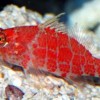Hawkfish are strictly marine fish of the family Cirrhitidae. They are associated with the coral reefs of the western and eastern Atlantic and Indo-pacific. The hawkfish family contains 12 genera and 32 species. They are popular because of their vibrant color, unproblematic upkeep and easy acclimation to the tank life. Popular kept species are longnose hawkfish (Oxycirrhites typus) and the flame hawkfish (Neocirrhites armatus). Most hawkfish are solitary in nature but some will form pairs and share a head of coral. Other species form harems of up to seven females dominated by a larger male.
Flame Hawkfish (Neocirrhites armatus):
This is most popular of all hawkfish. The flame hawk is bright red with black mascara around the eye and a black line along the back. This species will perch in a favorite spot and they occasionally roam up to a few spots in the tank. They adapt well to the aquarium life and generally learn to accept the food quickly. This species is one of the least aggressive Hawkfishes. They might be aggressive towards smaller, passive fish. You need to provide them with structures to perch on and nooks and crannies to hide in (it usually lives within branching coral heads).
It requires a 20gallon or larger aquarium. It is carnivorous and feeds on bottom dwelling invertebrates and zooplankton. Provide a varied diet that includes preparations for carnivore. It takes about 3 hours to acclimate after introducing to the tank. It does not bother corals normally, but may eat feather duster, feeding tentacles and small invertebrates. It’s maintenance is very easy.
Long Nose Hawkfish (Oxycirrhites typus):
This is a wonderful fish with red checkboard pattern on its white body. The nose is very long and uses it to locate its prey from the reef crevices. This is one of the least aggressive hawkfish and the most distinctive. You may keep one per tank, unless you’ve a very big tank. Provide with structures to perch on (it likes gorgonians and black corals) and hooks and crannies to hide in. It requires a 20 gallon or larger aquarium. It is also carnivorous and has excellent reef compatibility.
Geometric Pigmy Hawkfish (Plectranthias inermis):
Though, it is called a hawkfish, scientists have lately decided it isn’t a hawkfish. It is more closely relatied to anthias sub-family. It has a gorgeous blotchy pattern. It hangs out on its gigantic pectoral fins. When the lights are on, it prefers to sit beneath rock ledges. It is a perfect nano reef aquarium fish grows to a maximum length of just 2 inches. It is associated to hawkfish because of its overall shape and behavior. It needs a minimum of 10 gallon tank. It is also carnivorous and feeds on zooplankton.
Falco Dwarf Hawkfish (Cirrhitichthys falco):
It is a small and more peaceful hawkfish. This specimens are around 1-2 inches. They have spots that form bars on the side of the body and lines on the underside of the head. They have very intricate and colorful markings. They have bright yellow tufts on the dorsal fin rays. Falco dwarf hawkfish I easy to keep in saltwater aquarium. It needs a minimum 10 gallon tank. They are carnivores basically. They do well on live, frozen and flake foods. They need small feeds for a number of times in a day.
Freckled Hawkfish (Paracirrhites forsteri):
It is a hardy and a right choice for an aggressive community setting. It is bold and predatory species. Do not keep with fish that are smaller, because, it may swallow them. It needs minimum 55 gallon tank. It is carnivorous, too. It is completely safe with all corals, clams, etc. but will eat ornamental crustaceans and small fish.
Arceye Hawk ( Paracirrhitus arcuatus):
It is orangish-pink with a white line down the body and a bright orange ring with a blush border around the back of the eye. It is good for an aggressive community setting. It also swallows smaller fish. It needs a minimum of 20 gallon tank. Most specimens are around 2-4 inches. They are carnivorous. They are safe with corals and clams but eat ornamental crustaceans and small fish.








